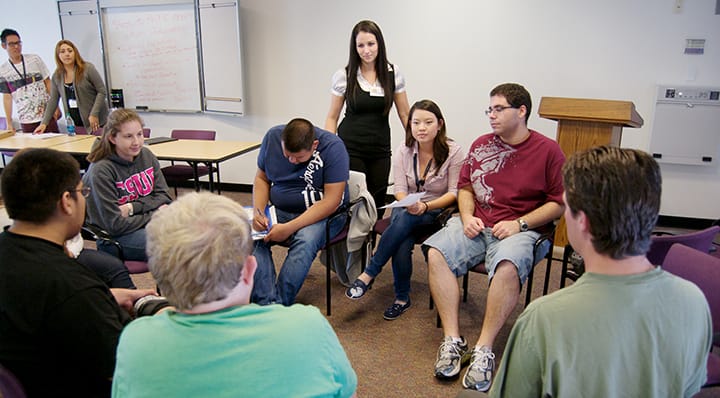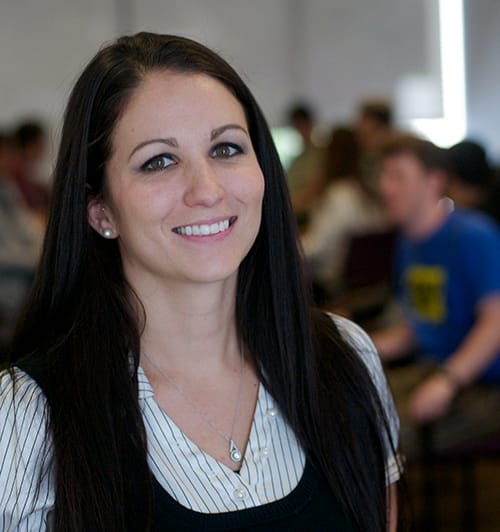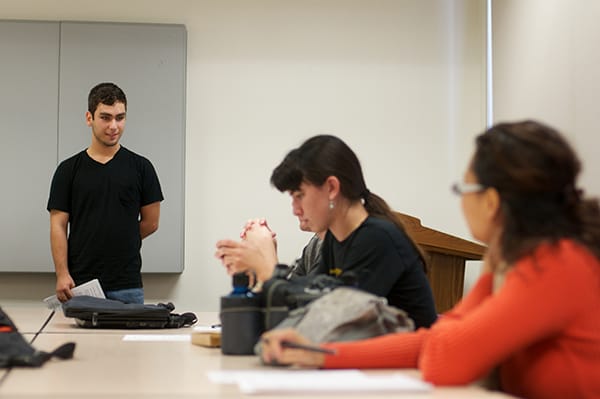SES student Nicole Smith Helps Students With Autism Spectrum Disorder

LIFE on the Spectrum: Autism Spectrum Disorder
Imagine this: You are sitting in a college classroom and, after a brief lecture, the professor instructs the class to form small groups to discuss the lesson. Students make eye contact with each other and wordlessly begin clustering together, as if on cue. But you don’t. In fact, you are frozen, confused, and unable to do what everyone around you seems instinctively able to do. If you are a student with an autism spectrum disorder (ASD), you’re likely to encounter this type of paralyzing situation on a daily basis.
This anecdote was told in August in a student meeting at California State University, Long Beach (CSULB). Like any other group of students, this group was chatting about course assignments, lamenting difficult professors, and snagging as much free pizza as they could. In fact, the only difference between these students and the rest of the CSULB student body was that this particular group was comprised entirely of students classified as having ASD, a disorder characterized by difficulties in social interaction, verbal and nonverbal communication, and repetitive behaviors.
The students were gathered for their weekly Learning Independence for Empowerment—or LIFE— Project meeting. That day’s topic was “self-advocacy,” a concept rooted in the civil rights movement and based on the conviction that people with disabilities can take control of their own resources and lives without the undue influence of the people from whom they require help. Learning the responsibilities of adulthood is daunting enough for an average young adult, but for college students with ASD, learning how to take control of their own financial, residential, and academic lives can be especially challenging. But these students have School of Educational Studies PhD student Nicole Smith as a guide, and LIFE is her brainchild.
With a BA in social ecology, an MA in special education, and multiple teaching credentials, Smith began her career at a K-12 “non-public” school—a school for students with emotional disturbances or ASD that public schools couldn’t handle. Many of the students came from juvenile detention centers, foster homes, or mental health facilities. To help these children and young adults as well as their families learn ways to maximize students’ chances for success in school and to advocate for students with disabilities, she started a nonprofit organization, the World of Learning Foundation.
Based on her success in the K-12 grade levels, CSULB contacted Smith in 2011 to start a program for its ASD student population. But what started as a social club quickly blossomed into a multi-faceted, grant-funded program to help these students, their families, the college, and ASD allies work together to promote life skills and better academic success rates for this population. To date, over 100 students have been through the LIFE Program.
“When I first started at CSULB, professors from various departments kept approaching me with questions on how to deal with and help these students,” Smith said. “It quickly became apparent that we needed more than just a club; we needed a program that would help students with ASD at every level, from the classroom to the administration. K-12 is doing a good job of giving these kids the tools to get to college, but these resources drop off when they get there.”
And they are there in spades.

According to the Centers for Disease Control (CDC) one percent of the US population has ASD; at CSULB alone, the past three years have seen a 300 percent increase in students on the autism spectrum, according to Smith. But whereas the national graduation rate for average students at a four-year college was 59 percent in 2011, according to the National Center for Educational Statistics, a 2000 study conducted by the same organization revealed that only one-third of students with disabilities earn a bachelor’s degree within six years of enrollment.
Smith’s LIFE Project aims to increase those numbers. The program has three components: The LIFE Project is a weekly meeting for ASD students to get coaching on setting goals and learning skills; LIFE Leadership is a more intensive program for students who have gone through the LIFE Project and want to focus more on getting a job, networking, independent living, and professional skills. Then there is the peer-coaching component, comprised of highly-trained, college-age interns who work closely with the LIFE participants to help set and monitor goals, practice interpersonal communication, and work on other issues that can be stressful or difficult for individuals on the autism spectrum.
These difficulties can be especially hard for professors and other professionals to detect, making life a constant barrage of misunderstandings for persons with ASD.
“When someone has autism, you can’t tell; you know something’s up but you can’t put your finger on it,” explained LIFE Leadership student, Tessa. “They’ll assume [intellectual disability] or substance abuse. Don’t assume the worst. I’m not ashamed of this; it’s not a dark secret. Just ask.”
Some of the traits of ASD include difficulty understanding metaphors or abstract reasoning; trouble picking up on social cues and cultivating a variety of interests; and challenges with executive functioning: the skills—like organization and time management—that enable someone to achieve goals.
But the same student who told the story about forming groups in the classroom also noted that she found a way to make the situation less stressful with a solution that worked for everyone involved.
“People just turned to other people like they were assigned,” she said. “I just sat there confused. How did the other students know who to turn to and get into groups with? Eventually, I learned how to make arrangements with professors to just assign me to a group.”
This student’s ability to approach a professor, explain her disability, and advocate for herself is exactly the type of progress Smith had in mind when she created the program.
“Simple things that neurotypical [or non-ASD] people take for granted, like understanding how to RSVP to an event, asking for clarification, knowing exactly how to balance a bank account or properly groom ourselves, even using social media appropriately, these are things that do not come as easily to individuals with ASD,” Smith said. “But some of our students have been with us for so long that they can see their own growth; they’ve received so much positive feedback from professors, peers, and parents…that’s what keeps them coming back to LIFE.”

In addition to directing the LIFE programs, Smith also developed autism-ally trainings and workshops for professors, staff, parents, undergraduate advisors, local and campus police, and the college administration. At the trainings, a panel of LIFE students shares their experiences and challenges, including the sensory discomforts—like sensitivity to loud noises or excessive visual cues—that can impact ASD individuals.
Smith has also written a 93-page manual aimed at providing in-depth discussions of and tactics for helping ASD students at the university level. She plans to publish the manual in the near future.
CGU has already employed Smith as a faculty advisor, where she instructs and supervises other CGU master’s students who are working toward the special education credential.
“I want colleges to start looking at these students and encourage them to have success in college. I think a lot of colleges are going to start paying attention to this,” Smith said.
“This Type of Mindset”
Each weekly LIFE Project meeting begins with students introducing themselves and answering a personal question. On that particular day in August, the question was “When did you feel that you were treated unfairly?” The answers ranged from the comical (“When I didn’t get enough free pizza!”) to the heart wrenching (tales of child- and adulthood-bullies, alienation, loneliness). But, as many ASD students and allies will attest to, their disabilities aren’t necessarily a hindrance.
“Students with autism or Asperger’s are as smart as anyone else—sometimes more so,” explained Smith. “Though they can have restricted interests, this actually allows them to focus intensely on very specific things. This type of mindset is where a lot of amazing discoveries and inventions come from.” (Indeed, Albert Einstein, Sir Isaac Newton, Michelangelo, and Charles Darwin are all thought to have been on the spectrum.)